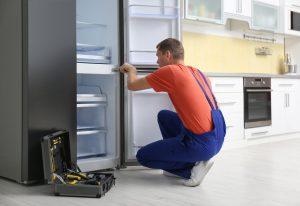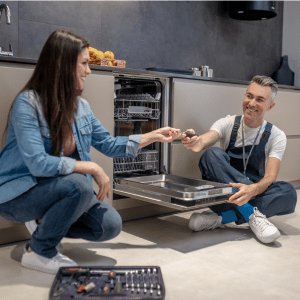Refrigerators are the basic need of every house, keeping edible items and medicines safe from getting infected with microorganisms. The usage is endless in a day so troubles might happen. Fridge repair according to people can be a daunting task but all it needs is a thorough examination. With the major issues left to mechanics, one can fix the minor ones on their own.

Problem # 1
The refrigerator is louder than usual
Do you see an unusual rise in the sound of the refrigerator? That can be due to several issues. Yes, refrigerators do make sounds. Expected and routine are the sounds of ice clattering into the storage bin and refrigerant hissing through lines. Even new refrigerators can make sounds.
Level the refrigerator
There are number of remedies for refrigerator. First, make sure it is level. The leveling legs should be adjusted periodically to ensure the doors can shut when opened halfway. You can use a wrench to turn the legs and change until the door swings shut.
Adjust the Refrigerator’s Icemaker
You may need to adjust the icemaker if your refrigerator emits a buzzing sound every 10 to 15 minutes. Check that the water supply valve is turned on and that the line behind the fridge is still attached and not leaking. If the ice maker is trying to make ice but cannot, turn it off or raise the ice sensor arm.
Replace Refrigerator Evaporator Fan Grommets
Finally, if the fan responsible for distributing air from the coils is rattling, it may be due to worn or broken rubber grommets. To fix this, unplug the unit, remove all items and shelves from the freezer, open the access door at the back of the freezer with a screwdriver, remove the fan, replace the old grommets with new ones, and then tighten and replace the fan. You can purchase inexpensive grommets online.
Problem # 2
The refrigerator is not producing enough cooling.
If the edible items are often infected, the problem lies with temperature settings and other issues. When you put your hand on the wire rack, does it not feel as cold as it should?
Adjusting the temperature settings of your refrigerator can be an easy solution to cooling problems.
However, it’s important to note that the thermostat may have accidentally changed, and some settings may be confusing.
To adjust the temperature, locate the thermostat inside the refrigerator and turn it down as low as possible until you hear the compressor click on it, then change it to the desired temperature.
Inspect Refrigerator Door Gaskets
The door gaskets of your refrigerator must form an airtight seal to keep cold air inside. Over time, these seals can become dirty and damaged.
To clean them, use warm water and apply a thin layer of petroleum jelly. If this doesn’t work, we should replace the gaskets.
Check Refrigerator Box for Blockage
Obstructions in the refrigerator can cause issues with cooling. Ensure no tall items are blocking the flow of cold air, and keep things away from air vents inside the refrigerator box.
Clean Refrigerator Condenser Coils
Dirty condenser coils can also hinder the cooling process. It’s recommended that these coils are cleaned every two to three months, especially in households with pets or high traffic.
To clean them, unplug the refrigerator, move it away from the wall, and remove the grille at the bottom. Use a vacuum to clean the coils carefully.
Add More Items to Refrigerator
If your refrigerator is low on food items, it may not stay calm when fully stocked.
A quick fix is to add two or three gallons of water in plastic jugs and allow them to chill. If you buy more food, replace the chilled water with the food.
Problem # 3
Leaking Refrigerators
Do you have water on the kitchen floor? And the water is spread all over the bottom resulting in a mess.
The most common issue with refrigerators is leaking. The same happens with water stuck inside the refrigerator, causing an unhygienic environment.
The most common problems are door gaskets, drain pans, and the defrost drain. You can fix them quickly.
Fix the door gaskets.
The door gaskets are a soft rubber-like seal that often gets leaked due to several reasons, i.e., aging and the frequent use of it.
One can clean them with water; if it persists, they Should replace them entirely.
Unblock Refrigerator Drain
Another issue with the refrigerator is the choking of the drain. You can clear it by removing any material or using boiled water to earn it.
Fix Drain Pan
If the drain pan at the bottom of the refrigerator becomes too full of water and starts to overflow, it should be emptied and cleaned with lukewarm water.
Avoid using abrasive cleaners. A mild bleach solution (1:10 bleach to warm water) can clean the pan to address mold or unpleasant odors. Rinse and dry it thoroughly before putting it back in place.
You can do several things to address issues with a refrigerator. One common problem is leaky door gaskets due to wear and tear from frequent use. Cleaning them with water may help, but replacing them consider recommended if the issue persists.
Another issue that can arise is a blocked or defrosted refrigerator drain. You can resolve this by removing obstructions or pouring boiled water down the drain to clear it.
Problem # 4
The refrigerator is producing too much cooling.
You want your freezer to be cold. But is it getting to be too much of a good thing? After you have tried readjusting the thermostat, using some hacks you can save the cost of fridge repair, here are some other repairs.
Check Refrigerator Damper
Cold air may be continually rushing into the compartment, unchecked by a damper stuck in an open position.
The damper is located between the cooling and freezing compartments and is controlled by the thermostat.
Replace Refrigerator Thermostat
Refrigerator thermostats are easily obtainable online. Find your model number on the inside of your door or the back, and then order a compatible thermostat.
If the problem persists, consider replacing the thermostat. You can easily find compatible thermostats online using your refrigerator’s model number. To replace the thermostat
- Make sure the fridge is unplugged and open the cooling compartment.
- Use a Phillips head screwdriver to remove the cover at the top of the cooling compartment (inside the box). There should only be a couple of screws holding it in place.
- Remove the plastic control assembly cover using the same screwdriver.
- Gently lift the cover down as it is attached to the refrigerator with wires. The thermostat will be a bronze-colored metal device attached to copper wires and a plastic capillary tube.
- It’s a good idea to take a photo of the wire arrangement before pulling them straight out by hand and removing the tube.
- Install the new thermostat as a one-for-one replacement, with two black wires doubled up and attached to one terminal, one orange wire, and one green ground wire.
- Attach the capillary tube.
- Replace the assembly covers using their matching screws.





One Response
this is best repairing site . I also thank because this is providing best service .